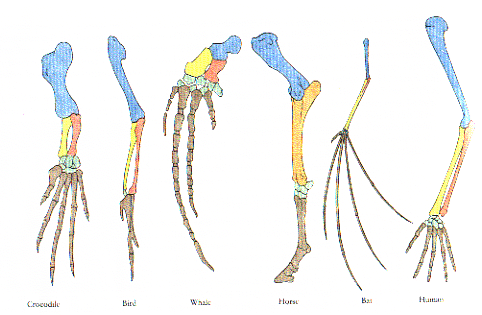Homology and convergence in morphology
Pentadactyl pattern in vertebrate forelimbs

This resemblence is often cited as evidence for common ancestry.
Is the evidence presented selectively?
Is the evidence truly distinctive to only one interpretation?
Counter evidence not often discussed:
a. Lack of correspondence of developmental pathways in some cases
"The classic examples of this problem are salamanders. In most vertebrate limbs, development of the digits proceeds from posterior to anterior - that is, in the tail-to-head direction. This accurately describes frogs, but their fellow amphibians, salamanders, do it differently. In salamanders, development of the digits proceeds in the opposite direction, from head to tail. The difference is so striking that some biologists have argued that the evolutionary history of salamanders must have been different from all other vertebrates, including frogs."b. pentadactyl pattern in vertebrate hindlimbsJ. Wells, Icons of Evolution, pg 72.The pentadactyl patterrn develops very differently in humans and in frogs. In humans, programmed cell death (apoptosis) divides the ridges into five regions that then develop into digits (fingers and toes). But in frogs, the digits grow outwards from buds, as cells divide.
see Langman's Medical Embyology, 7th ed. 1995 pg 154-157; and Tyler, M. J., Australian Frogs: a natural history, 1999, pg 80.
"But the hindlimbs of all vertebrates also conform to the pentadactyl pattern and are stikingly similar to the forelimbs in bone structure and in their detailed embryological development. Yet no evolutionist claims that the hindlimb evolved from the forelimb, or that hindlimbs and forelimbs evolved from a common source."M. Denton, Evolution: A Theory in Crisis, 1986, pg 151.
"There is no doubt that in terms of evolution the fore- and hindlimbs must have arisen independently, the former supposedly evolving from the pectoral fins of a fish, the latter from the pelvic fins. Here is a case of profound resemblence which cannot be explained in terms of a theory of descent.M. Denton, Evolution: A Theory in Crisis, 1986, pg 151.
"Whatever the ultimate explanation for this remarkable pattern turns out to be, there seems little intellectual satisfaction in attributing one case of correpondence to evolution while refusing it in the other."M. Denton, Evolution: A Theory in Crisis, 1986, pg 153.
c. There are many examples of striking morphological similarities that are clearly not due to common ancestry
Certain marsupial and placental mammals
